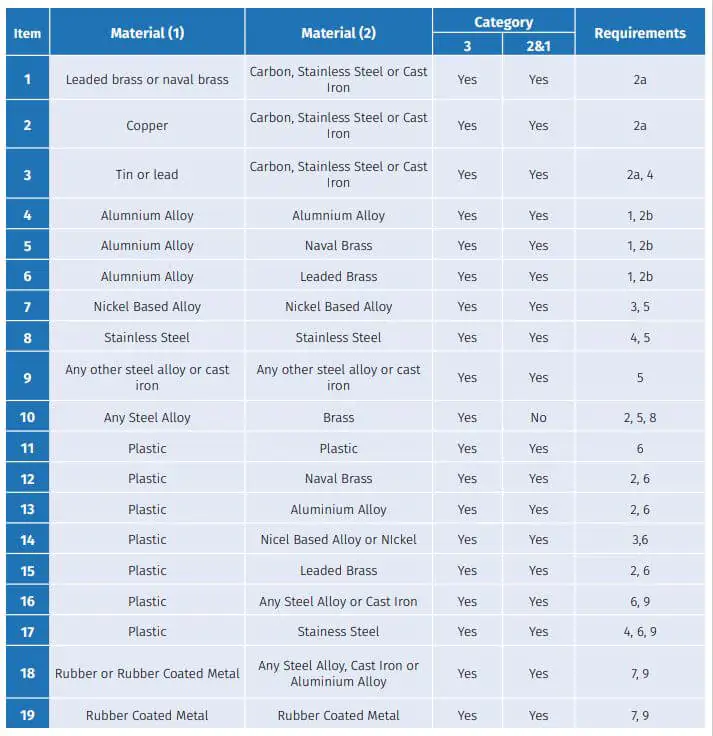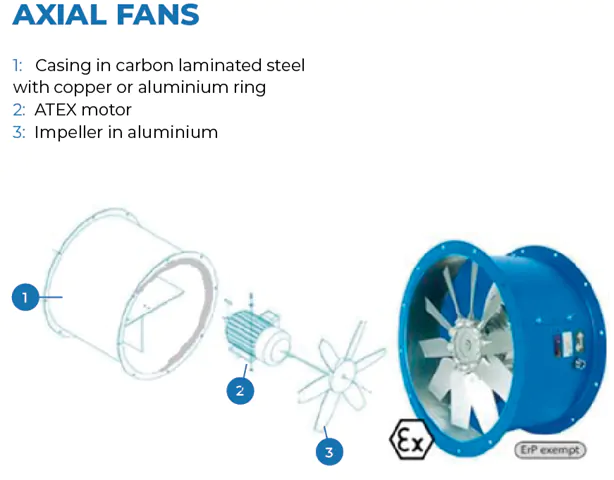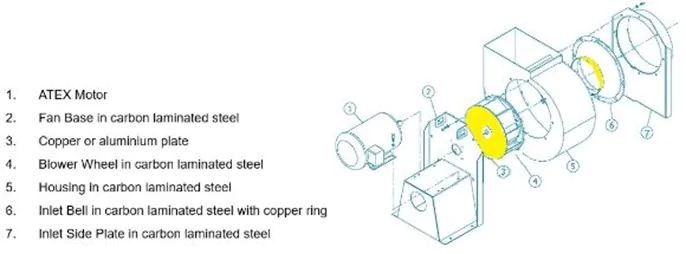Reduce Sparks & Friction Explosions with Permissible Material Pairings for ATEX Industrial Fans
Mechanical sparks and friction are one of the most common causes of ignition of flammable gases and dust clouds. Accident statistics in Germany indicate that mechanical sparks and friction as an ignition source occurred in 32.7% of incidents*1. Billange (1979) presented an overview of 66 incidents where gases and vapour were ignited by frictional ignition.
Can Incorrectly Selected Fans Cause Ignitions?
Incorrectly selected, or fans deemed unsuitable for hazardous areas, can produce an effective ignition source caused by various incidents; hot surfaces (such as damaged bearings), by mechanically generated sparks because of friction, impact, or abrasion processes (as a result of contact between the rotor – the rotating part, and fixed components) or by the electric discharge of static electricity when using non-conductive materials. Friction can cause static electricity.
Why are Permissible Material Pairings so Important?
In the normal operation, or in the event of malfunctions (whether standard or rare), possible friction caused by areas of contact can occur. As stated in the ATEX directive, and adopted into UK legislation, potential areas of contact between the rotating elements and fixed components of equipment for use in potentially explosive environments, should be manufactured from materials in which the risk of ignition caused by friction and friction impact sparks, hot spots or hot surfaces is minimised. This applies specifically to the construction and manufacturer of explosion proof industrial fans. Ignition risks cannot be completely eliminated but can be significantly reduced by taking suitable constructive measures for avoiding ignition sources. European and UK Directives are clear on the permissible material pairings that are suitable to reduce the ignition source caused by friction of these two areas: rotating and fixed. Material pairings are considered carefully by fan manufacturers and authorised bodies, who use their theoretical and practical knowledge, coupled with the known application conditions for the environment in question. The safest material pairing and other compulsory technical specifications that determine how a product is chosen for an explosive environment by taking a full holistic view of the ATEX environment. Material pairings are devised and communicated in legislation documentation to minimise the risk of an explosion. Industrial fans in systems or machinery, are generally not supervised continuously and contact between rotating and stationary, fixed components may occur in a particular area for an unknown amount of time, potentially in long intervals. The list of permissible pairings can be seen below:
Permissible Material Pairings for Gas Explosion Groups IIA & IIB


Metal to Metal Ignition
Metal to metal ignition is caused either by rubbing friction, as mentioned earlier, such as between a rotating impeller and a stationary piece of metal, or by impact of two metal objects. Research has shown that in metal-to-metal contact, the properties of the more readily oxidation metal, normally determine the degree of ignition hazard. The hardness, melting point, ignition temperature, specific heat conductivity and brittleness of the metals all play a role, in that they determine the size, duration, temperature and heat capacity of the incentive sparks. An important precondition for all the protection principles is that parts which are in unhindered contact with the explosive atmosphere must not be able to reach non-permitted temperatures with respect to the ignition temperature of substances present in the site of installation. This means that the ignition temperature is relevant for all protection principles. We cover temperature classes and surface temperature in a different section on our site. The standard EN14986 dictates minimum design rules that industrial fans for hazardous areas should comply with. In relation to the material pairings that we introduced earlier, the below seeks to improve your knowledge of the parts of ATEX fans that indicate the rotating and stationary parts that must be manufactured from these permissible materials to reduce the risk of sparks and hot spots due to frictional rubbing in the event of movement between the two parts.
In axial fans the two parts are: Rotating: Impeller, tip of the blades, and Stationary: The fan casing & ring


In centrifugal fans the two parts highlighted in yellow are: Rotating: Impeller, inlet, and Stationary: The inlet cone/ring


To learn more about our industrial range of ATEX fans please contact our team on [email protected], call 01782 349 430 or chat to our technical director using the button on the lower right.